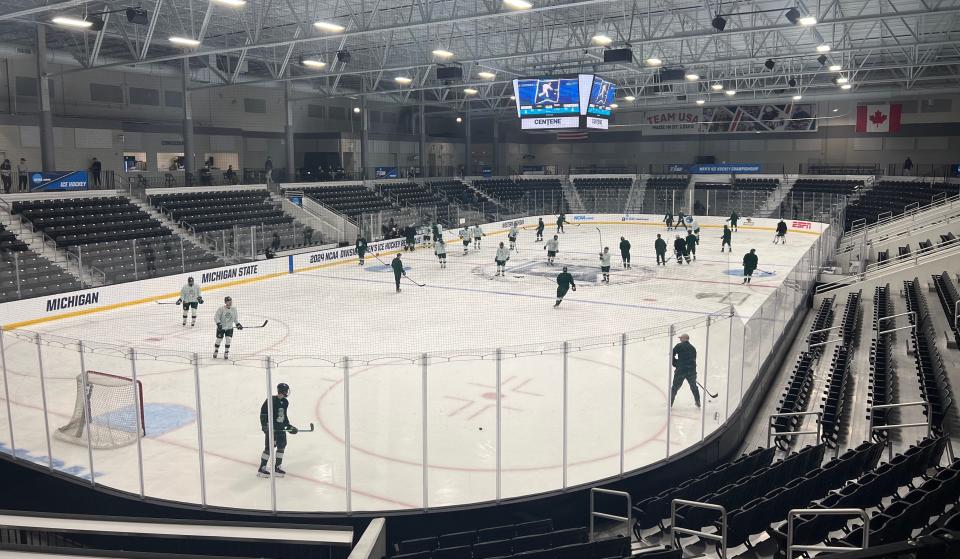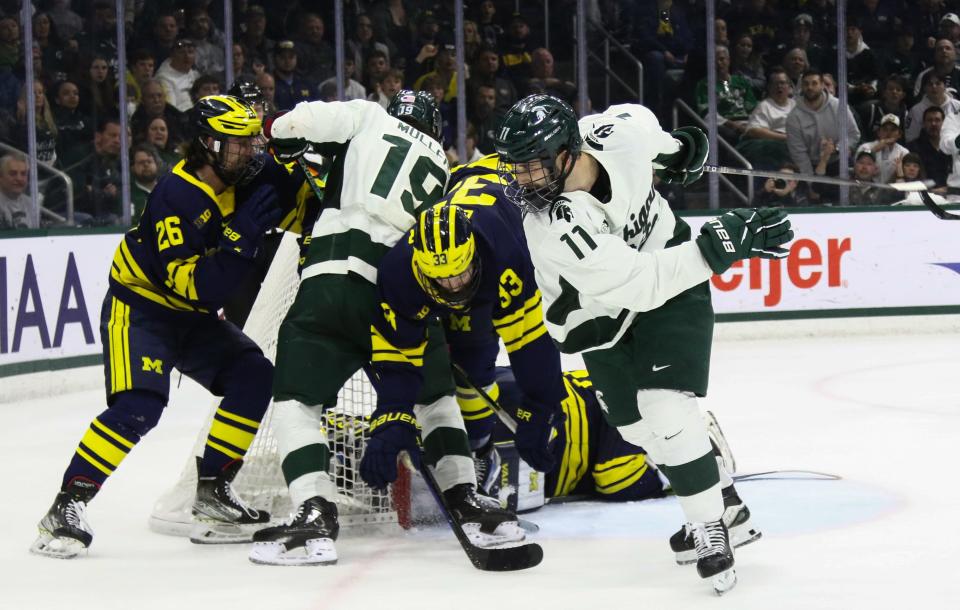Couch: College hockey's NCAA tournament needs some fixing. Here's how to do it.

MARYLAND HEIGHTS, Mo. – It does seem absurd that three sizable college hockey programs from Michigan and one from North Dakota are meeting at a 3,100-capacity rink in suburban St. Louis to play the biggest games of their seasons. But that can at least be explained.
You know what’s more absurd? That one single game this Friday will determine whether they advance to the next round of the NCAA tournament.
I’ve been waiting 12 years to write this column. Michigan State hockey has finally rejoined the party, facing Western Michigan on Friday evening (5 p.m. ET) at Lindenwood University’s home rink, before Michigan plays North Dakota, with the winners meeting Sunday in the regional final. And thus it’s time to point out the ridiculousness of an NCAA hockey tournament that’s single-elimination all the way through.
Worse yet, it’s a relatively easy fix, one that would also solve the issues this weekend of playing in an arena too small for the occasion and on a sheet of ice that's a six-hour drive from the closest team here.
MORE: Just jumping in? Three things to know about Michigan State hockey as NCAA tourney starts
I lied. I’ve been waiting 26 years to write this column — ever since I watched MSU as a 1 seed lose to Ohio State in overtime in its NCAA tournament opener in 1998. I remember thinking, “What was the point of that whole season?”
I understand the same could be asked about the end of the season for many teams in many sports many years. And, frankly, about life in general.
But hockey is best served up as a series — especially at this stage of the tournament. Sure, basketball is a single-elimination NCAA tournament, where the best team doesn’t always win. But basketball is a sport with more data points impacting the outcome — where teams are combining for 150 points rather than five goals, where one bad bounce isn’t as likely to be so punitive, where there’s often time to make up for a turnover that leads to a fast break or any other number of mishaps.
At the Frozen Four, single-elimination is fine. Necessary for TV and for the excitement of the weekend and to contain the event to one weekend. At that point, the teams have already earned their way there and are usually more evenly matched and, no matter what happens, they’ll hang a Frozen Four banner.
The rest of the 16-team tournament should be best-of-three series, beginning this weekend on eight different campus sites, on the home ice of seeds 1 through 8. The quarterfinals should follow next weekend, best-of-three again, on the campuses of the four remaining top seeds.
There is no reason to take next weekend off before the Frozen Four in mid-April, as is the case. No reason to avoid playing college hockey quarterfinals the same weekend the NCAA men’s and women’s basketball tournament’s Final Fours. You’re not worried about this weekend’s basketball games impacting audience. Why worry about the Final Four? You’re not worried about losing audience to Major League Baseball’s opening day — a sport with more crossover to hockey than hoops. You’re not even that worried about people seeing your hockey games at all. Three of your four regional finals this Saturday and Sunday are relegated to ESPNU, including Sunday night’s game here at Lindenwood.
So play next weekend.
“In a perfect world, our sport is a series sport,” MSU coach Adam Nightingale said. “The guys, before they get here, are playing in series. The league they want to play in (the NHL) plays in a series. But I do think there is something special about, ‘Hey, you’ve got to strap it on and be ready to go here.’ ”
It certainly makes for a tense setting. Sort of like Game 3 of a series.
Too much work goes into this — from summer conditioning through 36 games over more than 20 weeks beginning on Oct. 1 — for this to come down to one game this early in the postseason.
They used to do it right. For several seasons until 1991, back when it was a 12-team tournament, the first and second rounds — leading into the Frozen Four — were best-of-three series.
“It's a long, tough, great season,” WMU coach Pat Ferschweiler said. “And to go just in a one-game shot, I would love the best two of three, at least for the first round. Go to the home sites, get it back on campus. Some people say it gives too big of an advantage to the higher seeds. Well, they've earned that right to host. And then you're going to play in a great environment every time. And these kids, they want full buildings and excitement. That's what they're used to. Whether cheering for you or against you honestly really doesn't matter. There's energy and life in the building. And that's what I think we deserve.”
In that regard, they’ll get it Friday and Sunday. The Centene Community Ice Center, which is also the St. Louis Blues’ practice facility, falls under the preferred minimum 5,000 capacity for NCAA hockey regionals, with 3,148 being allowed in for these games. But with several sizable college hockey brands here, including MSU, which hasn’t been to an NCAA tournament in a dozen years, and North Dakota, which averages more than 11,000 fans for home games, this is a tough ticket.
Lindenwood was awarded the regional in part because they bid on it — “There were only a few venues in the western part of the country that submitted bids for the four-year cycle” in the winter of 2020, according to NCAA spokesman Philip Pierce. And because St. Louis is hosting next year’s Frozen Four, Pierce said, and they wanted to put college hockey in that market ahead of time.
“There's been lots of talk of the smaller building down here,” said Ferschweiler, who’s made the NCAA tournament all three seasons he’s been the head coach at WMU. “We’ve also been to regionals and bigger buildings that haven't been full. And so this is going to be a smaller venue, but it looks like it's sold out. It looks like it should have at least some energy and excitement.”

It’s not ideal. But, for the teams, it’s not awful. Same for the fans who can get in. Problem is, not enough of them can. The selection committee didn’t need to put North Dakota and Michigan here, either, which only increased demand. They could have put Maine and Cornell here, which actually would have also kept the bracket more aligned.
Still, under the current system, MSU could bid to host at Van Andel Arena in Grand Rapids if it wanted to. WMU could host at Wings Stadium in Kalamazoo. North Dakota did reportedly submit a bid to host this postseason and that’s added to the contention.
None of that solves the real issue — no way, no how this should be a single-elimination tournament.
Contact Graham Couch at gcouch@lsj.com. Follow him on Twitter @Graham_Couch.
This article originally appeared on Lansing State Journal: MSU hockey is part of a flawed NCAA tournament. Here's how to fix it.

